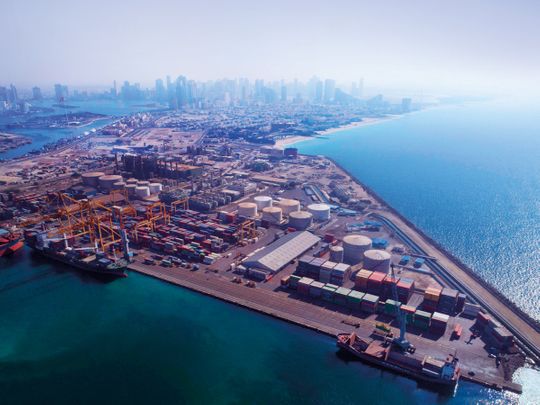
Port authorities across the region are correcting course to stay relevant as customers demand more efficient solutions, while an increasing number of players pose competitive risks. Onboarding new technologies and cross-border collaboration are major routes forward, as GCC operators have recognised.
“A new approach is necessary as certain practices are now outdated and it is essential that the operational systems of all GCC ports function as competitively as possible,” Sultan Ahmed Bin Sulayem, Chairman of Ports, Customs and Free Zone Corporation (PCFC) and Dubai Maritime City Authority (DMCA), tells GN Focus.
Globally, transport infrastructure investment is projected to increase by about 5 per cent annually through to 2025, according to PwC. By then, expenditure on sea port infrastructure is expected to have doubled from its 2014 benchmark. In the UAE, some $65 billion (Dh238.7 billion) was invested in the country’s maritime sector last year, according to figures from the country’s infrastructure development ministry.

A new approach is necessary as certain practices are now outdated and it is essential that the operational systems of all GCC ports function as competitively as possible.
“Customers are looking for speed, transparency, efficiency and effectiveness, and as such investment focus is based upon optimising the customer experience,” Bin Sulayem adds. “First-class infrastructure that delivers a commercially viable and effective solutions is at the heart of that consideration.”
Volume growth
Capacity expansion is the first step as regional states seek to diversify their economies away from a reliance on hydrocarbons, although some experts have warned against excess capacity.
“Port capacity is one of the most prominent issues,” says Bin Sulayem. “As larger berths and container terminals enable more vessels to dock at ports and greater quantities of cargo to be processed, capacity is one key focus.”

Today, digitisation and innovation have become a global imperative, and one the Middle East cannot risk lagging behind on.
In 2018, Khalifa Port in Abu Dhabi agreed an investment deal with China’s COSCO, to grow future handling capacity to 9.1 million TEU over the next five years. Dubai’s Jebel Ali already handles 19.3 million TEU and is expected to add another 3.1 million TEU by the end of this year.
Saudi Arabia and Kuwait are also seeking to grow capacity. Meanwhile, Sohar Port and Freezone in Oman says work is progressing well on its Sohar South development, a 250-hectare expansion. The port is now looking at leasing out its Terminal 2D, Mark Geilenkirchen, CEO of Sohar Port and Freezone, says, describing the move as a way to bring in new customers from outside the region.

With several regional ports currently running out of space, Sohar still has the capacity to further expand and attract prospective investments.
“With several regional ports currently running out of space, Sohar still has the capacity to further expand and attract prospective investments.”
Technological response
Technological solutions such as container termination automation and drone patrols offer a way of addressing long-term maritime trade-processing issues and improving operational efficiency and security.
Ports including King Abdul Aziz Port in Dammam, Khorfakkan Container Terminal (KCT), Dubai’s Jebel Ali and Oman’s Salalah Port have all adopted port information and management software systems to provide real-time, holistic operational overviews.
Technology infrastructure alone accounts for a market size of $5.3 billion by 2024, from an estimated $1.7 billion in 2019, according to a ResearchandMarkets.com report, as more and more authorities seek to create smart ports powered by disruptive new developments such as big data, artificial intelligence (AI), the internet of things (IoT) and blockchain. Effectively, smart ports will see a CAGR of 25 per cent over the next five years.
“Today, digitisation and innovation have become a global imperative, and one the Middle East cannot risk lagging behind on,” says Peter Richards, Group CEO of Gulftainer.
“Smart infrastructure is at the core of this transformation in the ports and shipping industry. It is the wind behind the sails of enhancements such as automation, capacity-building and high performance, all of which are crucial for companies to stay competitive in a fast-evolving business environment.”
He believes big data will have the largest impact. “Data will be the biggest enabler going forward. Used effectively, data can unlock many new possibilities and address legacy challenges that have so far impacted port operations.”
Cross-border collaboration
In a globalised world where cargo typically crosses several national borders, a single inefficient port can slow down the entire supply chain. Beyond operational consolidation, leveraging IT solutions can help optimise the flow of traffic between harbours. The first cross-national partnership of its kind, chainPORT, already operates between 13 different port cities around the world.
Similarly, ports across the Arabian Gulf are teaming up for mutual benefit, Bin Sulayem says. “We place a strong emphasis on working together to enhance all areas of the maritime sector, promoting an innovative game theoretic model that facilitates benefits, funding and equality to all associated organisations,” he explains.
“This model is integral to the maritime industry moving forward as it will have a significant impact with regards to establishing avenues to assist strategic initiatives, driving smart transformation across all ports and tackling regional economic issues.”
Gulftainer enhances service offerings
Fred Castonguay II, Group Chief Operating Officer, Gulftainer, on smart transformation of port operations:
How are the ports operated by Gulftainer in the region moving towards smart transformation?
Across our portfolio, we continue to invest in new technology to serve our customers better. We successfully implemented the state-of-the-art Marine and Container Handling (MACH) Terminal Operating System (TOS) and SAP S/4HANA business suite, which have helped streamline key business processes in the region and increase terminal productivity.

We recently unveiled the Sharjah Port of Trade (S.P.O.T) services, a new strategic sea cargo clearance offering. With unparalleled connectivity between Sharjah and Dubai, S.P.O.T enables a reduction of delivery costs from port to door by as much as 80 per cent.
What new efficient systems have you introduced for customs and cargo clearance and the delivery services?
We recently unveiled the Sharjah Port of Trade (S.P.O.T) services, a new strategic sea cargo clearance offering. With unparalleled connectivity between Sharjah and Dubai, S.P.O.T enables a reduction of delivery costs from port to door by as much as 80 per cent. In addition, the port offers enhanced online customs clearance, 24-hour access to major roads, as well as a state-of-the-art facility for on-site cargo inspection, quality sampling, and testing services at the importer’s premises.
Demonstrating the success of this new offering is the GALEX service (GLX), which successfully completed the first direct call at Khorfakkan Container Terminal (KCT) in a record 3.4 hours.
What’s your broad outlook for the UAE maritime sector? How does the situation align with Gulftainer’s vision for the future?
There is no denying that global trade has faced considerable headwinds in recent months, although the overall mood in the market is optimistic. With the UAE playing an ever-increasing role in the industry, including its vital contribution to the Belt and Road Initiative, the next few years look promising. As one of the pioneers of container trade in the region, Gulftainer has continually been in alignment with the UAE’s trade ambitions. In fact, we have directed large-scale investments locally in Sharjah and Khorfakkan. As a result, these two ports are among the top-performing facilities across our global portfolio — a trend we expect will continue for many years to come.
— GN Focus report













